Have you built a website but your visitors just aren’t doing what they’re suppose to? They aren’t interactive: they don’t comment, don’t click, don’t sign up, and don’t buy. This may be because your web design is non-effective. It does not reach its end goal. You want more people to comment on your posts yet you don’t ask questions or bring up topics that make commenting irresistible. You want people to buy from your site but you lay out so many options in front of them all at once that they simply browse and leave. They may close the window because your site doesn’t even display properly on their cell phone or browser, or loads slowly due to the dozens of massive images you’ve put up.
An effective web design serves a purpose. It’s useable and does the job it was designed to do. A pretty site that is hard to navigate is not effective. Remember when it was popular to display navigation links as cute images with no text or hint of where they lead to? It looked nice but it was very annoying for the end user.
So, what are the three key elements to an effective design?
- A Balance of Form and Function

You often hear that form follows function. In a way, this is very true. The way your website looks should help in serving its purpose. Figure out what the requirements of the website are first and then design around that.
There does need to be a balance between these two elements. Focusing primarily on function results in a boring and uninspiring-looking page. Yet focusing primarily on form lessens the usability of your site. A confusing but aesthetically appealing web page is even more likely to be clicked away from than a boring page. An unbalance of either can lower your web design’s effectiveness.
- Reach

Effective web design means being able to reach the maximum amount of users. If you’re not doing this, you could be leaving money on the table. Your design should be responsive, mobile and tablet friendly, not to mention displays well on all monitors and browsers (yes, even Internet Explorer). Fast loading times and an excellent user experience will help make your traffic stick instead of seeing the majority of them clicking away.
You can extend your reach to users by determining your target market and using digital marketing and marketing tools and techniques.
- Conversion

Everything comes down to conversions and web design is directly related to this. By conversion, I am referring to whatever you intend your visitors to do, whether it be buying a product, clicking a link, calling a phone number, or entering an email address. Web design clutter such as unnecessary widgets, plugins, billions of social media icons and the like can decrease your conversion rates. Increase conversion rate is the first consideration when you start your web design.
Meanwhile, making sure your site is easy to use and keeping important elements above the fold can be effective in raising your conversion rate.
An effective web design works with the user the moment they hit the page, every element leading them strategically to the desired action. How effective is your website?






